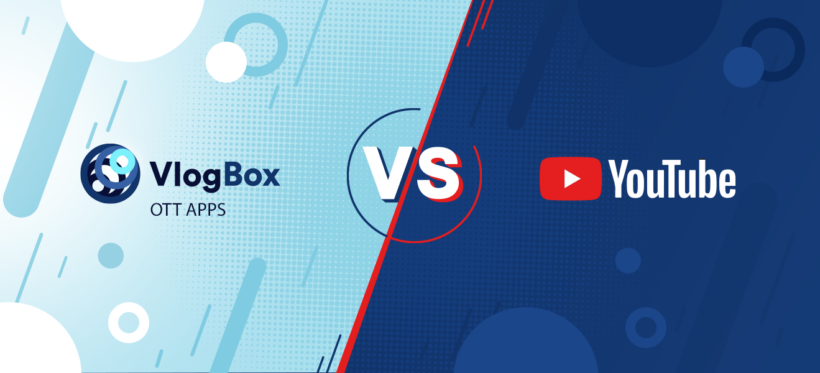However long a video is, from a few seconds up to dozens of minutes, video has an amazing ability to engage viewers. It helps marketers with lead generation, enhances ROI, improves website traffic, and boosts sales. Videos are also turning out to be a marketable source of entertainment. People are switching from appointment viewing – that is, watching a single show at a specified broadcast time – to binge-watching on OTT platforms. These over-the-top (OTT) platforms host a huge library of content that could be accessed on-demand.
How content consumption on YouTube is different for VOD apps
YouTube and OTT platforms are the biggest sources for delivering video content. eMarketer predicts that the number of YouTube viewers in the US will grow from 214.9 million in 2020 to 228.1 million by 2024. But one question remains – is it better to create a YouTube channel for hosting videos, or use a different OTT channel?
What you should know about YouTube
YouTube is a free video hosting platform that generates money for advertising viewership – in other words, it uses the advertising video-on-demand (AVOD) monetization model. That means that YouTube videos are likely to have ads inserted before, in the middle or at the end of the video. However, the ads shown by YouTube can not be influenced – it’s all algorithmically determined by YouTube itself.
Additionally, YouTube offers creators another option for income generation with YouTube Premium. This revenue may vary depending on how much Watch Time content creators have received from premium subscriptions. That means more revenue can be earned depending on Watch Time views. On top of that, the Premium cut for YouTube is 45% – the same share as for ad generated revenue.
The Premium model may seem less promising than AVOD monetization, but it has potential you should shoot for. Since video content on YouTube is available either for free or in a paid version, there are equal chances to enhance viewership and earnings.
What type of content is delivered across OTT channels
Many may think of videos as the main type of content delivered across OTT channels. However, there are some other types as well. Let’s dig deeper and find out what they are.
OTT Video Content
Video streaming is undoubtedly all the rage for the last few years in the digital TV landscape. Thousands of people worldwide consume a wide range of OTT videos about lifestyle, travels, sports, education, and entertainment. Platforms like Netflix, Apple TV, and Hulu, provide subscription-based access to videos. Meanwhile, others, like YouTube, have the option of ad-free content available for a certain fee.
OTT Voice Calling Platforms
It might be a great surprise for WeChat and Skype users, but these video call platforms refer to OTT services. They use internet protocols and can integrate with cellular networks to provide enhanced phone and video call services for their users.
OTT Messaging Service
Every time you bypass traditional SMS communication over the mobile phone, you use OTT-based instant messaging platforms like Facebook Messenger, WeChat, and WhatsApp. They ensure instant messaging via Wi-Fi or a 4G connection.
OTT Audio Apps
It’s no secret that audio content has burst into the media market and become a new norm. Music streaming services (Spotify, SoundCloud, Apple Music), internet radio stations, and podcast platforms provide access to all types of audio content. Users have to download an app and connect to the OTT to listen to their favorite music, interviews, discussions, etc.
Tips for a smooth content transition
Choosing the right streaming platform is equally important as creating engaging video content. It’s easy to get lost in the vast array of the OTT channels, but here are some tips on easing the transition.
Keep these points in mind when streaming your video content on other OTT platforms:
- Find a suitable platform that is relative to your GEO and type of content. You should also look into the nitty-gritty details in order to obtain a comprehensive picture of the channel-creation process and learn more about possible pitfalls.
- Secondly, develop an app. Plenty of platforms give you a hand in app creation and launch. This factor is really important because it helps you save lots of time and effort. You don’t have to look for an outsourcing team, but can use a service that directly cooperates with your OTT channel provider.
- Next, check out whether you can customize your app. Why does that matter? Your audience has likely already gotten used to your design. They may associate you with particular elements and colors, which help them distinguish your channel from others.
How to benefit from an OTT app?
With an OTT application, you can grow closer to your audience. On average, Americans spent 67 minutes a day watching OTT video content in 2021, and this figure is expected to reach 70 minutes a day in 2022. That pushes OTT apps from simply a trend to a necessity for content creators. An OTT app enables you to premiere on new platforms that can help you raise your brand awareness and find new audiences.
With just a little effort, one can find numerous OTT apps on popular platforms like Amazon Fire, Apple TV, and download them on set-top devices, media players, and other gadgets. Content creators can develop apps for their own channels to go beyond YouTube and reach out to a larger audience.
What’s more, OTT apps provide ample monetization opportunities that support SVOD and AVOD models. Content owners can either use both models or analyze video consumption trends on their app to monitor, adjust, and opt for the most suitable monetization solutions.
Takeaways
Everyone who creates video content should pay attention to both OTT platforms and YouTube, which can help meet and engage with new viewers. Before jumping into either ecosystem, you should be aware of all the opportunities and possible roadblocks. However, the risks are worth it.

